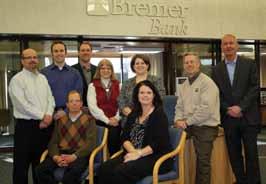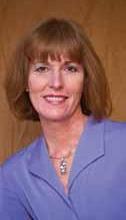Economy
Perfect Pursuit – Leaders attract business to central Minnesota. Pg 30

community
Diaper-clad Economy – Early childhood education and the bottom line. Pg 38
PhilanthroPy
Board Service – What to ask when you’re asked. Pg 10
4th Quarter 2012 page 22
- Patti, Pequot Lakes
When Patti Field learned she had breast cancer, she saw a surgeon two days after her diagnosis and had surgery the next week. A month later, Patti didn’t hesitate when she was asked to participate in a clinical trial.

“I was all for it. There was no hesitation whatsoever. It’s research and it could help someone. You know, it may help my grandkids or my great-grandkids.”
At the Essentia Health Cancer Center at St. Joseph’s Medical Center in Brainerd, patients have access to the latest technology and treatments and the most current oncology clinical trials. For more information, visit us online at EssentiaHealth.org or call us at 888.829.2861 or 218.828.7130.
EssentiaHealth.org
Photo above: Patti and her husband Butch with their dogs Snickers and Hershey, at their home in Pequot Lakes, MN.
I’m so happy I’m here because I enjoy life and I’m not giving up.
Online Identity

Websites,




Developing a successful online brand takes more than a flashy website with a contact us button. It takes sales strategy, persuasive copy, emotional imagery, purposeful design and an all-encompassing plan. Let’s work on this together. After all, a worldwide audience awaits. Learn more by calling 218-454-3210 or visiting RedHouseMedia.com.


into every web launch.
Thought
eCommerce, social media, SEO and SEM
(218) –FRANKLIN ARTS CENTER –BRAINERD,
facebook.com/redhousemedia
— all the necessary online tools, provided under one red roof. STUDIO
MINNESOTA

Features 22 snow Business Snow, and the lack of it, can cause a wintry mix in the regional economy. 30 Perfect Pursuit St. Cloud leaders attracted an international giant to central Minnesota. Here’s how they sealed the deal. 34 after You Succession planning allows leaders to rest assured their business will continue long after they’re gone. 38 Our Diaper-Clad economy Early childhood education and the bottom line. DePartments 6 Initiatives The Foundation’s Regional Investment Highlights. 10 Board service What to Ask When You’re Asked –How can you tell if a nonprofit board position is right for you? 12 economy Been There – What’s your most important advice for a new entrepreneur? 16 Community Heart Times – Downtown revitalization pumps up Annandale. 18 Philanthropy Give and Get – Charitable Gift Annuities: Fixed payments to donors on the front end, charitable gifts to nonprofits on the back end. 50 Home made Smude’s Sunflower Oil, Pierz –Products made right here in central Minnesota. 52 Where is IQ? Tabl e of Contents initiative Foundation Quarterly 4th Quarter 2012
cold cash: The Brainerd Jaycees $150,000 Ice Fishing Extravaganza can lure up to $1 million in revenues to the region. This year’s crowds braved sub-zero temps during the January 19th event. 2 Initiative Foundation Quarterly ifound.org
Photo by Crystal Simon






Visit our website at www.anderson-center.org for forum dates and locations, to meet our Discussion Leaders, and to learn more about how the Anderson Center can be used to develop and strengthen leaders and create value in your organization. Challenge yourself. Challenge your organization. Experience it. www.anderson-center.org l 320.251.5420 RESIDENTIAL COMMERCIAL INDUSTRIAL u Aggregates u Washed sand and rock u Landscape rock u Pre-cast concrete u Concrete sealer u Ready-mix concrete u Concrete pumping and conveying www.KnifeRiver.com (218) 829-4726 | (800) 450-4726 Baxter | Pine River | Crosslake | Deerwood | Staples Let’s discuss your next project. Widseth smith NoltiNg.com | 218-829-5117 alexandria | baxter | bemidji | crookston | east grand forks | grand forks | red wing | rochester ENGINEERI engineering architecture ARCHITEC LAND SURVEY land surveying ENVIRONMEN environmental services 4th Quarter 2012 3
Dear Friends,
“No, I’m serious!” I said of my plans to marry Neal and move to Minnesota. “The lakes freeze, and the ice gets so thick that people can actually drive trucks on it! They cut holes and catch fish!”
My southern California friends giggled and shook their heads. They were intrigued but didn’t want to appear too gullible. When we arrived in the Land of 10,000 Frozen Lakes after our California wedding, I thought that maybe it was me who was bamboozled. It was 1977, and the thermometer read 44 degrees.
Below zero.
It represented a 121-degree swing between Pillager and Pasadena, where the Vikings were losing to the Raiders in the Super Bowl. I should have known something was up when Neal’s sister gave us an electric blanket for a wedding gift.
My first winter lesson? How to plug in my car before electric cars were invented. Our first home was a vintage manufactured unit, complete with straw bales, wood heat in the “lean to,” extra plastic on the windows and water running at night to keep pipes from freezing. At least we weren’t lonely, as many creatures preferred our home to the great outdoors.
While my West Coast friends can’t fathom thousands on Gull Lake for the Ice Fishing Extravaganza, seasonal road signs on Lake Mille Lacs, or the snowmobilers who like to jump open water (a seriously stupid thing to try), I now know that these winter activities are critical to our region’s economy.
Our IQ cover story is another nudge to think differently about economic development. Of course, everyone knows that weather can impact tourism and manufacturing. These industries also affect other products and services in the economy. And the economy impacts our communities and philanthropy.
Somehow, it always comes back to snow in Minnesota.
Enjoy the magazine!
Kathy Gaalswyk President


Printed at Range with Soy-Based Ink on Recycled Paper Volum E 10, 4 th Quart E r 2012 initiati VE F oun D ation President | Kathy Gaalswyk Vice President for External Relations | Matt Kilian Marketing & Communications Manager | Anita Hollenhorst ED itorial Managing Editor | Elizabeth Foy Larsen Writer | Laura Billings Coleman Writer | Sarah Colburn Writer | Gene Rebeck Writer | Larry Schumacher Writer | Andy Steiner Writer | Laurie Stern Writer | Maria Surma Manka art Creative Services Coordinator | Eric Rittmann Photographer | John Linn Photographer | Justin Wohlrabe a DVE rti S in G / S u BS cri P tion S Advertising Director | Brian Lehman Advertising Manager | Lois Head Advertiser Services | Eric Rittmann Subscriber Services | Katie Riitters 405 First Street SE Little Falls, MN 56345 320.632.9255 | www.ifound.org IQ Magazine unlocks the power of central Minnesota leaders to understand and take action on regional issues. rangeprinting.com 4 Initiative Foundation Quarterly ifound.org
“Hi.”



National Joint Powers Alliance® (NJPA) is a member-driven service cooperative with a membership now exceeding 50,000. NJPA offers a multitude of programs, contracted products, equipment and service opportunities to local education, government and other nonprofit entities. Visit our website to learn how we can help you.







Happy to call Staples home...Proud to serve the region.


Improving the Way You L o ok at Life Comprehensive Eye Examinations, Complete Contact Lens Care, Children’s Vision Care, Diagnosis & Treatment of Eye Diseases, The Best in Eyewear
Dr. Michael Marvin Dr. David Pelowski
Brainerd, 218-829-1789, 1-888-420-2015 Nisswa, 218-963-2020, 1-877-963-2010 Pine River, 218-587-2020, 1-888-970-3937
202 12th Street NE • P.O. Box 219 • Staples, MN 56479 • 888-894-1930 www.njpacoop.org
get to KNOW US 4th Quarter 2012 5
Initiatives
Regional Investment Highlights
A Clean Plate

Wadena County
A business loan from the Menagha Community Loan Fund —administered by the Initiative Foundation—will help A Clean Plate purchase real estate, equipment and inventory to start a grocery store that will focus on natural and locally grown food.
Match Maker
Cass County

With help from VISTA member, Linsey McMurrin, the Hackensack-Onigum-Walker-Ackley Family Center in Walker is promoting and expanding their Kinship mentoring program, which matches students with community members for a long-term, supportive relationship.

Early Investments
Todd County
The Foundation awarded a grant to the Freshwater Education District (Staples) to support the integration of early childhood screening data across five school districts within Cass, Morrison, Wadena and Todd counties. This data is used as an invaluable tool, resulting in enhanced success for all students










Welcome, Dan!
Morrison County
Dan Meyer, co-founder of Atomic Learning (Little Falls) on being a new Foundation trustee: “I have viewed the Foundation as the personification of the statement “Think globally, act locally.” Being asked to be on the Board of Trustees is a significant honor ”

Dedicated Donors
Stearns County
Donors since 2009, Don and Rita Kainz recently contributed to the Foundation's endowment with a year-end gift. Don and Rita are originally from Pierz and rural Stearns county, respectively, and chose to contribute because they "believe in the mission of the Foundation.”
Fully Furnished
Benton County
With help from VISTA member, Joe Gibbons, the Central Minnesota Re-Entry Project is expanding and increasing community awareness about their Community Furniture Program, which provides low income households with essential furniture and other household items.

Cooperation Wright County
A grant to the Buffalo Housing Redevelopment Authority will help analyze competition, potential membership base, sales forecast and other data needed to evaluate whether the area can sustain a food co-op. The potential business could help attract additional traffic in the downtown area.
6 Initiative Foundation Quarterly ifound.org
Welcome, Tammy!
Crow Wing County
Tammy Filippi has joined the Initiative Foundation as our new part-time Early Childhood Associate. Filippi will work with the region’s early childhood coalitions and other regional and community-based early care and education initiatives.

Millions for Manufacturing
Pine County
Pine Technical College (Pine City) is one of four Minnesota colleges to share a $13 million grant from the Department of Labor to expand programs that train workers for high-wage, high-skilled manufacturing jobs. Other colleges include St. Cloud Technical and Community College, Central Lakes College and Bemidji State University.
Financially Resilient
Kanabec County


Industries, Inc., a nonprofit that provides training and employment services to people with disabilities, was one of eight organizations recently accepted into the Foundation’s new Financial Resiliency and Social Enterprise program, which helps nonprofits become more financially sustainable by identifying alternative sources of revenue.
It Starts Here
Mille Lacs County
In order to entice businesses to fill vacant storefronts, the City of Princeton recently offered incentive packages worth up to $20,000 for new businesses looking to open downtown. The contest ended in late January and businesses will be chosen soon.

Million Dollar Mark
Sherburne County
The Three Rivers Community Foundation (TRCF) passed a major milestone in the organization’s 24 year history, exceeding $1 million in assets. TRCF is a community fund of the Initiative Foundation which matched TRCF’s goal of raising $50,000 in 2012.

Endowment Boost
Isanti County

Connexus Energy, a longtime partner of the Foundation, recently renewed a three-year pledge to support the Foundation’s community and economic development efforts. Every dollar donated to the Foundation’s endowment is matched dollar-for-dollar by The McKnight Foundation.




Safe Visits

Chisago County
Chisago County was one of four counties to receive a grant award from the Initiative Foundation to provide safe, supervised visitation services for children who have an incarcerated parent. The services are provided through FamilyWise Services, Minneapolis.



4th Quarter 2012 7



8 Initiative Foundation Quarterly ifound.org














4th Quarter 2012 9
What to Ask When You’re Asked
How can you tell if a nonprofit board position is right for you?
By Laurie Stern | Photography by Justin Wohlrabe
Eunice Adjei-Bosompem is passionate about improving life for low-income immigrants.

Born and raised in Ghana, she moved to St. Cloud in 2004 to attend St. Cloud State University and started serving on the St. Cloud Regional Human Rights Office advisory board. In 2010, Tri-County Action Program, Inc. (Tri-CAP), an anti-poverty program in central Minnesota, tapped Adjei-Bosompem for its leadership development program. A year ago, she applied to be on that board. “I liked their mission and vision,” she said. “I wanted to make an impact on the community.”
Today, many nonprofits are recruiting for open board seats. How can you tell if an opportunity is right for you?
The Initiative Foundation recommends you ask yourself what you’re interested in and
how much time you have for board service. Are you willing to roll up your sleeves for a young nonprofit that needs a worker bee, or would you prefer a more established organization?
Besides representing the organization in the community, nonprofit board members typically set policy and oversee finances. But boards, as Adjei-Bosompem discovered, can be vastly different from one another. Tri-CAP, for example, focuses more on programming than the human rights committee does. “You’re speaking for a lot of people, not just yourself,” she said. Understanding that difference was an adjustment for her.
But beyond taking your own inventory, experts say it’s crucial to talk to the organization to determine if you are a good fit.
Here’s what to ask when you’re asked.
Do their mission and goals fit yours?
This match is critical to both the success of the organization and to your personal and professional goals.
What can you contribute?
Make sure your skills and interests align with what the board needs. “Board members need to know that their time and talents are being invested in the best way possible,” said Linda Holliday, vice president for organizational development at the Initiative Foundation. If you can see that your efforts will change lives in positive ways, it will draw you in and keep you engaged.
Philanthropy
10 Initiative Foundation Quarterly ifound.org
match Game: Eunice Adjei-Bosompem explored a board position at Tri-CAP, an anti-poverty organization. Dan Roberts serves as community development director.
Can you be a donor/fundraiser?
Most boards ask for a financial commitment to the organization. Oftentimes board members are also expected to help fundraise and open doors to more donors and funding opportunities.
What is the financial situation?
“If an organization is in dire straits, you’d want to know before agreeing to serve.”
Holliday said. Poor finances may not be a deal breaker, especially if you enjoy rescuing and rebuilding. But you should know the situation before you join.
Do you have enough time to commit?
Make sure you’re able to commit the amount of time they expect and still manage other priorities in your life. “Some of our best board members are the busiest people,” said Renee Hendricks Olson, executive director of Child Care Choices in St. Cloud (CCC), a participant in the Initiative Foundation’s Thriving Organizations Partnership program.
What is the term commitment?
You’ll want to find out how long a board term lasts, and whether you can serve multiple terms. Will you be expected to recruit your replacement or replacements for other board members?
How will I know if we move the needle?
Ask the nonprofit how they gauge outcomes to measure their organization’s impact. Unless they’re just starting out, an effective organization should have a strategic plan—whether formal or informal— that proves they’ve given some thought to their direction and how they plan to achieve those goals.
What is the committee structure?
Board members may be expected to serve on one or more committees. It’s important to know the committee structure, purpose, membership and meeting frequency.
Can “I try before I buy?”
“Attending a meeting or two can give you a feel for the personalities on the board and whether they are a well-functioning team,” said Holliday. Meetings should be interesting and productive. At least half of each session should be devoted to planning for the future.
Is there a continuity of leadership?
The search for leadership positions, especially executive directors, can be time-consuming and stressful. Stable leadership frees the board to do other things. That’s not to say that being part of a search isn’t rewarding. If you excel at staff recruitment or retention, that may be the role for you.
Beyond these key questions, the bottom line is that you must have a deep interest in the organization’s work. “If you’re passionate about the mission, you will enjoy the meetings,” said Dan Roberts, community develpment director, Tri-CAP. That’s what Adjei-Bosompem discovered after observing for the first few months of her term on the Tri-CAP board. “I have found my voice,” she said. “And I’m using it.”
AN ENGAGED COMMUNITY
Community Engagement is a cornerstone of a St. Cloud State University education—at all levels. Our professors, like Mark Springer, dean of the College of Liberal Arts and the School of the Arts, teach their students that getting involved is an opportunity and an expectation. Dr. Springer is the principal trombonist with the St. Cloud Symphony Orchestra and deeply involved in the St. Cloud arts community. He truly leads by example.
More than 45 percent of the musicians in the St. Cloud Symphony Orchestra have ties to St. Cloud State, and the University is pleased to serve as host for Orchestra performances.
Community Engagement: A cornerstone at St. Cloud State

www.stcloudstate.edu 4th Quarter 2012 11
Been There
By Andy Steiner | Photography by Justin Wohlrabe
Some believe it takes a high tolerance for risk to make it as an entrepreneur. Others say startup success requires a healthy ego. And then there are those who think high flyers reach the top by practicing a measured calm in the face of stomach-churning turbulence.
But what does it really take to succeed? Successful central Minnesota entrepreneurs who’ve managed to turn their dreams into thriving businesses say they are often asked that very question.

One thing that’s certain, according Central Minnesota Small Business Development Center director Barry Kirchoff, is that starting a business isn’t for the faint of heart. The success rate of small startups in central Minnesota follows a national pattern, with a failure rate as high as 80 percent in the first five years.
Even with such daunting odds, central Minnesota’s strong infrastructure of support for entrepreneurs makes it a good place to start a business if you have what it takes to succeed. That’s why we asked three successful Initiative Foundation business financing clients to share their advice for budding entrepreneurs hoping to get a leg up in the business world.
Diana mini
Founder
- Shark Industries, Rockford
We manufacture abrasive products and package automotive products and welding supplies; currently employing 33 people. As a woman, when I first went into this business 30 years ago, I was a novelty. But I quickly learned that if you know what you’re talking about, people take you seriously. At Shark, we’ve had some tough times, but over the last three to four years, we have been growing anywhere from nine to 14 percent.
Diana’s advice for entrepreneurs
A Capital Idea
There are all kinds of books written about the key characteristics of a successful entrepreneur, but obviously one of the most important things to possess when you’re starting out is enough capital.
Math Facts
You have to know how to read a financial statement and really understand your finances from the inside out. Don’t just leave it to the accountant. I don’t know how many times bankers tell me, “It is nice to work with you because you know your numbers.”
On Time
No matter how long you think it’s going to take for your business to become profitable, you have to double that amount. Starting a business from scratch will require many hours if you are to be successful. I would say that for the first 10 years, I worked 12 hours a day during the week and six hours per day on the weekends.
What’s your most important advice for a new entrepreneur?
Business
12 Initiative Foundation Quarterly ifound.org
tom haGlin
President - LINDAR Corporation, Baxter

We are a thermal-forming manufacturing business whose major product line is the plastic food packaging that’s used for bakery and deli products. Early on we probably made about 100 different items. Twenty years later we exceed 2,000 and have gone from 15 employees to about 100.
Tom’s advice for entrepreneurs
Natural Resources
Identify your weaknesses and strengths. Maybe you’re strong in sales and marketing but don’t understand the financial side. It’s important that you identify those gaps and align yourself with trusted individuals who have backgrounds in your weak areas. They should review your plan and check periodically to make sure you’re on the right track.
Ask The Experts
Turn to your local economic development centers or the small business development centers in your community. They can help you put together your business plan and guide you along those first few steps of setting up shop.
Passion Play
Make sure you have passion for the actual work. Recently, I met with two individuals who were looking to open up a fitness center. When they presented their financials, I had to tell them, “If things go well it looks like you might make a little bit of money, but in the end it will hardly be enough to pay yourself a salary. It’s not viable. But if it’s something you want to do because it is your passion, then that’s a different story.”
JoEl chriStianSon
President - Cinch Systems, Inc., St. Michael Cinch Systems, Inc. produces electronics for intrusion detection systems and vehicle barrier systems for customers with high-security needs. Our products protect the U.S. Supreme Court and numerous other government agencies.
Joel’s advice for entrepreneurs
It’s About the Money
The first question you have to ask yourself is, “Do I have enough money to make my business truly succeed for the long haul?” Then take that amount of money and triple it. I’ve always found that people underestimate the cost of starting a business. They see the end product, but they don’t see the steps needed to make it happen. That’s the hidden cost.
Risky Business
I think it’s very important for entrepreneurs to make sure that employees understand what they are up against when they work for a startup. The risks are greater but the payoff can be much higher.
Insurance Policy
When interviewing prospective employees, let them know that cash flow may not be smooth at first, and they’ll need to work long hours—after six years, I still put in 60- to 80-hour weeks. A prospective employee should know up front that they may need to have another way of supporting their families, whether it’s a spouse or a side job that can keep them afloat in tough times.

4th Quarter 2012 13
For 100 years, Larson Boats has been sewn into the fabric of the American dream as one of the country’s hardest-working hometown brands. Through the ups and downs of a century, one thing has never changed: Larson’s commitment to our community.
Larson Boats is dedicated to providing good jobs for generations, producing a quality product the community can be proud of, and sharing wholesome family fun by shipping boats around the world, that brings us all closer together.


So this year, Little Falls, let’s celebrate the last 100 years and look forward to 100 more!

LARSON BOAT GROUP
www.larsonboats.com
AFTER A CENTURY OF QUALITY BOAT BUILDING, WE DECIDED IT WAS TIME TO BRING BACK A TRUE CLASSIC ... THE ALL AMERICAN 23 Al faiths or beliefs are welcome S E N I O R A PA R T M E N T S P lease call (218) 829-1429 for more information. www.good-sam.com GoodSam_IQGene_7.75x4.625_Layout 1 5/14/12 3:01 PM Page 1 14 Initiative Foundation Quarterly ifound.org
www.striperboats.com
www.triumphboats.com 1913 2013
Skilled medical care for total peace of mind.

For complete home health services, including skilled medical care, trust the people who’ve been here helping your neighbors since 1984. Remember, there is a difference.

We’ll be there.
(218) 829-9238 | (888) 221-5785 www.gnhomecare.com

4th Quarter 2012 15
Heart Times
The central Minnesota city of Annandale boasts a bustling downtown anchored by a gleaming new library and generations-old family businesses like Miller’s Jewelry and Arenson’s Pharmacy.
“Downtowns are usually the heart and soul of their communities,” said Dan Frank, program manager for community development at the Initiative Foundation.
According to the National Trust Main Street Center, the payoff for public and private investment in a downtown is tremendous: For every dollar invested in physical improvements, cities may expect up to an $18 return in jobs and business income.
However, Annandale has worked hard to get to its position of success and opportunity. In 2003, the Initiative Foundation convened a cross-section of the community to figure out how residents could work together to improve Annandale’s image as a bedroom community.
The city of 3,000 was an early participant in the Thriving Communities Initiative, an Initiative Foundation program that provides community and economic development grants, leadership training and technical assistance to nearly 100 central Minnesota communities.
A healthy downtown also creates a local identity that increases community pride and the overall quality of life, according to Kelly Hinnenkamp, the Annandale city administrator. She said their downtown’s impact goes beyond tax base, service delivery and jobs. “It plays a key role in the local
By Laurie Stern | Photography by
economic success of Annandale by showcasing its culture,” she said.
That commitment to promoting local talent is on display all over the town. Almost every public space—and many private ones— display the work of local artists. Free live music, art crawls and a farmer’s market keep the hub humming from May to October.
A lot of small towns have a hard time keeping their downtowns vital because there are so many more places to buy things,” a reference to the array of offerings in larger cities nearby.
Each hometown has their own unique approach to downtown improvement. For example, Montrose has decided to improve their business district along Highway 12. Wadena installed art deco lights, painted historical murals and created new signage. Waverly is considering options for a downtown that was left vacant when businesses relocated to the highway. Princeton brainstormed a contest where city and local businesses offer $20,000 in incentives to entrepreneurs who want to start businesses downtown.
That’s music to the ears of Patti Vandorp, who opened the In Hot Water Coffee-Tea House thirteen years ago. Today, the 625-square-foot coffee shop is an informal community center. Teenagers hang out, seniors gather for coffee, and community leaders work on plans to keep improving downtown.

Those plans turn into action. Volunteers raised money to restore a city beach and designed new bike and walking trails that lead downtown. A vacant lot was replaced by a public park.
“Communities like Annandale thrive because a variety of local citizens come together to create a common vision and to take action as partners,” said Frank. “This ability is what separates them from others.
“The beauty of our community is that the infrastructure is in place and the tax base is good,” said Laura Beckman, who chairs Annandale’s Arts Action Team. “We’re able to work on the quality of life here; those things that make you want to live in a community.”
Join the Annandale Area Community Team and the Initiative Foundation in Annandale for lunch, discussion and a tour on Saturday, April 27th from 10 a.m. to 1 p.m..
For more information or to reserve your spot contact: Robert Muschler rmuschler@ifound.org 320-631-2048.
Justin Wohlrabe
Downtown revitalization pumps up Annandale
Espresso Economics: In Hot Water Coffee-Tea House is both a thriving business and Annandale’s informal community center.
Community
“Communities like Annandale thrive because a variety of local citizens come together to create a common vision and to take action as partners.”
Want to learn more about Annandale’s story?
16 Initiative Foundation Quarterly ifound.org





Nisswa Community Center | 218-963-0085 22x40 dance floor | 299 occ. cap. | smoke-free bar rental | kitchen | clean-up | tables and chairs all included www.ci.nisswa.mn.us/cc/index.htm Ye Old Pickle Factory | 963-0085 Downtown Nisswa | Open Daily | www.yeoldpicklefactory.com Spirits of Nisswa | 963-7488 Across from Schaefer’s Grocery | www.spiritofnisswa.com CityNisswa.IQ.W12.ad_Layout 1 1/13/12 10:32 AM Page 1 The backbone of a great community is a strong economic foundation. At the Greater St. Cloud Development Corporation, we harness and facilitate collaboration among the vast resources of our region to foster, attract and assist growing businesses and top talent. The way we see it, good businesses make great neighbors. If you feel the same, we’d love to talk. greaterstcloud.com 320.259.0300 Building a stronger s t. Cloud region. one B usiness at a time. 4th Quarter 2012 17
Give & Get
By Maria Surma Manka | Photography by John Linn
Gloria MacMillan Cessna’s father launched his beverage distribution business with one driver and one truck. From those humble beginnings grew a large enterprise, and his success allowed his children to live and give generously. Cessna, 83, feels the responsibility.

“I’m passionate about helping small businesses succeed,” she explained. “It’s really what makes America work.”
Cessna serves on the board of the Milaca area’s Rum River Community Foundation, which is hosted by the Initiative Foundation. Small town and small business success stories spurred her to consider a long-term giving option to support each Foundation’s work.
Partnering with the Initiative Foundation, she chose to establish a simple, yet little known vehicle called a Charitable Gift Annuity (CGA). It works like this: A donor makes a contribution to a trusted charity. The charity agrees to make fixed lifetime payments (usually to the donor and/or a spouse). Upon their passing, the remainder goes to the charity.
“It’s good for the individual investor and for the recipient,” Cessna said. “I just signed a few papers and it was done. I’m delighted every time a check comes in the mail.”
According to Matt Kilian, Initiative Foundation vice president for external relations, CGAs are especially attractive to retirees who want to support a charity but need an annual income they can count on. Online comparisons show current three to five-year CD rates yielding below 2 percent annually. By comparison, a CGA set up for one 65 year-old person can yield 4.8 percent.
The rate is based on formulas from the American Council on Gift Annuities, which primarily consider the donor’s age (the older
Charitable Gift Annuities: Fixed payments to donors on the front end, charitable gifts to nonprofits on the back end.
Philanthropy
18 Initiative Foundation Quarterly ifound.org
Gloria macmillan cessna: “It pleases me to know that I’ve been of some help to worthwhile projects.”
Managing Print Expenses
We hear you’re looking for ways to decrease costs. Expenses are justifiably top-of-mind for all businesses today.


team of print specialists can show you simple and productive ways to track and manage your printing costs. Our team not only knows the print industry, they’ve also been trained to listen. Want to chat about how much you could save? We’re all ears.

go.css.edu/IQJan + (866) 287-8740 Keep moving ahead with The College of St. Scholastica - o ering on-campus, accelerated and online programs that t your schedule. + Business & Technology + Health Sciences + Nursing + Education
in
This principle applies to more than just physics.
LAW: New campus coming fall 2013! marconet.com Marco helped a national optical retailer see the money they could save on their print costs. To read the whole story, visit www.marconet.com/SeeTheSavings
Objects
motion tend to stay in motion.
NEWTON’S
Marco’s
4th Quarter 2012 19
Get Input On Your Output Costs.
the donor, the higher the annuity rate). Once the rate is set, it can neither decrease nor increase.
“Most people don’t know that you can give and get,” Kilian said. “The system is built to reward people like Gloria for their generosity. In this case, the Foundation also wins because the remainder of her gift supports our work after the payments end.”
As with any financial investment, there are factors to consider, noted Jerry McCarter, CPA and retired principal at CliftonLarsonAllen. For example, while CGAs are backed by the assets of the nonprofit, the investment may be lost if the organization goes bankrupt.
“When considering a CGA, trust is the most important factor in the equation,” Kilian said. “Is the nonprofit financially
I’ve got investments all over the world, but in this case, I know my money is being used to help people in my state. It pleases me to know that I’ve been of some help to worthwhile projects. It doesn’t get any better than that.
stable? If your gift is designated to a fund or program, is that documented? Are the rates and details clear?”
Both Kilian and McCarter encourage donors to speak with a tax advisor to determine whether an annuity is the best choice to meet their financial and charitable goals. Donors can research nonprofits by asking about accreditations or visiting websites like charitiesreviewcouncil.org or guidestar.org.
Cessna believes the choice was right for her—she even established a second CGA— and she looks forward to more central Minnesota small businesses growing into big success stories.
“I’ve got investments all over the world,” she said, “but in this case, I know my money is being used to help people in my state. It pleases me to know that I’ve been of some help to worthwhile projects. It doesn’t get any better than that.”
Charitable Gift Annuities
What is a Charitable Gift Annuity?
A charitable gift annuity is a way to make a gift to your favorite charity, and still receive an income for yourself or others. It is a contract under which a charity, in return for a transfer of cash or other property, agrees to pay a fixed sum of money for a period measured by one or two lives.
Who Might Benefit?
Most gift annuity donors are retired, want to increase their cash flow, seek the security of guaranteed payments and would like to save taxes.
• The interest rates on their CDs and other fixed-income investments have declined, and they would like to increase their cash flow.
• They own appreciated stock or mutual fund shares and have considered selling some of the shares and reinvesting the proceeds to generate more income, but they don't want to pay tax on the capital gain.
• They would like to count on fixed payments, which are unaffected by interest rates and stock prices and which they cannot outlive.
• They want to assure continuation of payments to a surviving spouse without the delay of probate proceedings.
• They would like to provide financial assistance to an elderly parent, a sibling, or other person in a tax-advantaged manner.
Sample Rates of Return
age
rate age
rate age rate 55 4.0% 69 5.0% 80 6.8% 56-57 4.1% 70 5.1% 81 7.0% 58 4.2% 71 5.3% 82 7.2% 59 4.3% 72 5.4% 83 7.4% 60-61 4.4% 73 5.5% 84 7.6% 62-63 4.5% 74 5.7% 85 7.8% 64 4.6% 75 5.8% 86 8.0% 65 4.7% 76 6.0% 87 8.2% 66-67 4.8% 77 6.2% 88 8.4% 68 4.9% 78 6.4% 89 8.7% 79 6.6% 90+ 9.0%
Source: American Council on Gift Annuities, for illustration purposes only.
20 Initiative Foundation Quarterly ifound.org






22 Initiative Foundation Quarterly ifound.org
There’s No Business Like Snow Business
 By Laura Billings Coleman | Photography by Justin Wohlrabe
By Laura Billings Coleman | Photography by Justin Wohlrabe
The latest forecast from the experts at the National Oceanic and Atmospheric Administration called for a cold, dry winter for Minnesota—the kind of long-range weather pattern that can make an ice fisherman’s heart glow with anticipation. While this has augured well for the Brainerd Jaycees $150,000 Ice Fishing Extravaganza and all the businesses around Gull Lake that rise on the tide of the world’s largest charitable ice fishing contest, not everyone was ready to celebrate just yet.
“The weather report says there’s some snow and cold weather coming this weekend,” said Nancy Krasean, the marketing manager at Cragun’s Resort and Hotel on Gull Lake, said in early December. “But that doesn’t always mean it will happen.”
Krasean had good reason to be cautious. Last year, weather dowsers from the Farmers’ Almanac said the region would see average snowfall and very cold temperatures—perfect conditions for the skiers, snowmobilers and ice fishing enthusiasts that pump more than $507 million into Minnesota’s winter economy, according to the National Resources Defense Council. Instead, 2012’s unseasonably brown winter compelled organizers to cancel the annual Mora Vasaloppet nordic ski race, postpone the Ice Fishing Extravaganza for three weeks and force the crew at Mount Ski Gull to work overtime making snow that never got any traction. The new fleet of 30 snowmobiles Cragun’s purchased to plow through the season’s predicted powder sat unused all winter.
Though the weather may be unpredictable, there’s no question the cold plays an important part in central Minnesota’s economic forecast. The region is rich in businesses that benefit from snowy weather, from snow machine maker Arctic Cat in Thief River Falls, to Little Falls Machine, which manufactures snowplows that clear winter roads across the country, to Brainerd-based Mills Fleet Farm, which sells snow-blowers, tire chains and shovels to snowbound customers across the upper Midwest. An estimated 8,500 jobs statewide are dependent on winter tourism, ranging from the small family operations that rent ice fishing houses on Mille Lacs, to large resorts like
Snow, or the lack of it, can cause a perfect storm in the regional economy.
4th Quarter 2012 23
Breezy Point and Grand View Lodge, which often see reservations rise with the snowfall. Cragun’s Krasean estimates that winter whiteness can boost nearly everyone’s bottom line “by 10 or 20 percent.”
Just consider the economic impact of the state’s over 250,000 registered snowmobilers, who have made the Paul Bunyan Trail a favorite destination for the last decade. According to the University of Minnesota Tourism Center, each snowmobile trip made in the state accounts for more than $45 in expenditures, adding an estimated $172 million to local economies.
With so much depending on the weather, it’s no wonder many business owners and civic groups in central Minnesota are working hard to “weather proof” their winter business, making sure they’re prepared to ride the wave of a white winter, while ensuring they have the reserves to buffer themselves against a brown one. Don Hickman, vice president for community and economic development at the Initiative Foundation, says it’s a trend taking hold across the country, as warmer than average winters have threatened winter-dependent local economies in 38 states from Maine to Colorado.
In fact, a recent report from the Natural Resources Defense Council and the environmental advocacy group Protect Our Winters predicts that if current trends continue, the country’s winter tourism industry could lose as much as $2 billion a season as the cold weather recedes. According to the study, the difference between a good snow
Jordan, the chairman, CEO and president of Arctic Cat, which has a plant in Thief River Falls, and an engine parts plant in St. Cloud. Though the company’s international reach and product line that now includes more wheeled machines than snowmobiles insulate Arctic Cat against the ups and downs of a Midwestern winter, Jordan said there’s no question a significant snowfall can boost the company’s bottom line, inspiring the snowmobilers to hit the trails, and spurring dealers to order extra parts and fresh inventory. “When other people see white out there, we see green,” he said.
year and a bad snow year saw a decline of nearly 140,000 skier visits in Minnesota— an estimated $9 million loss for the state’s resorts. “It certainly makes sense to recognize that economic activity can’t be seasonal,” said Hickman. “You have to create opportunities to succeed year-round.”
cold cash
“When I wake up in the morning and see snow, I feel much better,” said Claude
Of course, not every business in central Minnesota dreams of a White Christmas. Flurries and freezing temps generally signal the end of the construction season, according to Craig Schoenberg, a second generation owner of Schoenberg Construction in St. Cloud, who says that last year’s mild winter made it possible to continue construction projects well into December.
“Milder winters are definitely better for our business,” said Bonnie Supan, general manager of Brenny Transportation Incorporated in St. Cloud. That’s because

cragun’s marketing manager nancy Krasean estimates that winter whiteness can boost nearly everyone’s bottom line “by 10 or 20 percent.”
24 Initiative Foundation Quarterly ifound.org
nancy Krasean, Cragun’s Resort and Hotel
the transportation sector usually sees a surge in fuel and heating prices in the winter, while big freight orders are held off until spring. And while manufacturing is not as seasonal, some companies in the region can see snow-related surges, according to Reggie Clow, CEO of Clow Stamping and a trustee of the Initiative Foundation. “More snow can mean more snowmobile parts, while a poor winter can affect their purchasing,” he said.

In fact, a mild winter can pile up big savings for cities and municipalities. Last year, Ansel Township spent just 10 percent of its allotted snow removal budget, according to board of supervisors member Miles Auschel, a third-generation cattle rancher in Cass County, who added that a warm winter can be a mixed blessing for farmers and ranchers, who may save feed and fuel costs when there’s little snow cover, but may risk winter kill for some crops, soil erosion and pest problems in the spring. “For us, the very best conditions are when you’ve got about six to 12 inches of ground cover,” said Auschel. “It’s fine when it’s cold, but not twenty below.”
While most “indoor businesses” such as finance, insurance and real estate stay
steady from one quarter to the next, others see surprising surges that depend on conditions outdoors. Home health care services get busy after the holidays when sidewalks are slippery and “adult children are home to notice that mom and dad could use a little assistance,” said Jay Vasek, owner of Comfort Keepers in Little Falls. Just the
frosty temps as essential ingredients to their getaways.
right combination of low snow cover and freezing temps can also heat up business for plumbers like Dale Jindra, owner of Brainerd Lakes Sewer Service, who says when sewer lines and septic tanks freeze up, “we’re busy for a while.”
Snow Brings Families
Still, few feel these weather-related business fluctuations as keenly as those who cater to the region’s winter tourists—many who see snowfall and
“The way I see it, snow brings the families,” said Adam Arnold, one of the owners of Reed’s Sporting Goods in Walker and Onamia. According to Arnold, the state’s ice fishing culture is “so well developed that we’ll always have the passionate, hardcore users” who come to their favorite frozen lakes no matter how frigid or slushy the conditions. “When you have the snow component, they bring the whole crew.” Two-day guy getaways turn into four-day or week-long family vacations, with tourists who are more likely to take part in a variety of activities, from shopping in Nisswa, to testing the slides at one of Brainerd’s indoor water parks.
Though summer accounts for almost 40 percent of the year’s tourism dollars in central Minnesota, the winter season helps bring in more than $15 million in leisure and hospitality sales taxes—nearly a quarter of the annual $65 million tourism-related tax revenue the central Minnesota region earns each year. But if the right conditions don’t materialize, it can be a big challenge for small business owners to make up the
arctic cat cEo claude Jordan
4th Quarter 2012 25
“When i wake up in the morning and see snow, i feel much better. When other people see white, arctic cat sees green.”
lost revenue, according to Tina Chapman, director of the Mille Lacs Area Tourism Council, who also runs a resort and guide service that caters to the ice fishing crowd. “Last year, the ice was so iffy, I’d say a lot of businesses lost half of their usual winter business or more,” she said.
At the Brainerd Jaycees $150,000 Ice Fishing Extravaganza, excellent ice conditions can make the difference between attracting fewer than 10,000 contestants to the charity fishing event, or the nearly 15,000 organizers need to turn the tent city on Gull Lake’s Hole in the Day Bay into “the largest city in Crow Wing County.” Though the event typically raises more than $200,000 for local charities, the real beneficiaries of this influx of winter tourists are local hotels, resorts, restaurants, grocery stores, gas stations and bait shops that can count on a mid-January boost that adds more than an estimated $1 million in economic impact for the area.
Weather-Proofing
Some businesses pray for snow. Black Pines Beach Resort owner Lynn Scharenbroich prefers to put her faith in good plumbing. When Scharenbroich and her husband Bob added five winterized cabins to their Pequot Lakes resort, they made sure to
install plumbing and heating systems that can be shut down completely when they’re not in use. Rather than market their resort to snowmobilers or fishing fans who may be disappointed when the conditions aren’t perfect, Scharenbroich promotes the conditions they know they can always deliver, reaching out to past customers “who don’t

the season” packages, including food and wine weekends, Super Bowl celebrations and “Spring Break on the Lake” made last winter “our best ever.”
Outdoor enthusiasts are proving equally adaptable to changing weather conditions. When last year’s lack of snow threatened to idle her 20-dog sledding team—a favorite
if current trends continue, the country’s winter tourism industry could lose as much as $2 billion a season as the cold weather recedes.
care a fig about anything other than a crackling fire, a bottle of wine and a good book.”
Indoor attractions—such as the water parks in Brainerd and Baxter, or the ice arena in Breezy Point—also provide a helpful layer of insulation against poor weather conditions, as steady streams of incoming hockey teams or young families help keep hotels and restaurants busy.
Going after guests who prefer to see the outdoors rather than be in the outdoors has been a successful strategy for Grand View Lodge in Nisswa. “I’ve been in the resort business for 33 years, and we used to be much more dependent on what the weather was doing,” said Grand View general manager Mark Ronnei. In spite of the lack of snow, he says, a series of “reason for
attraction for resort guests in Brainerd— Charlotte Wolf of Wolf Moon Kennel added a sled with rubber wheels. Brainerd birdwatcher Judd Brink says that the trails that call to snowmobilers and Nordic skiers have helped grow his guided birdwatching tour business, which can be enjoyed throughout the year.
Even businesses that are built on snow are learning how to buffer themselves against brown winters. Celebrating its 50th season, Mount Ski Gull in Nisswa opened nearly three weeks earlier than usual this year with a snowtubing run and a terrain park where kids can bang and grind down a series of metal rails. “It’s definitely a different mindset for us,” said executive director Dale Bosch. “ Instead of trying to open a
26 Initiative Foundation Quarterly ifound.org
mark ronnei, Grand View Lodge
dozen ski runs, we’re focusing on opening a few of them and doing them really well.”
With its snow-making capabilities, Mount Ski Gull is also offering help to other organizations and businesses, providing practice time for high school ski teams, sharing discounts with area tourists disappointed by the lack of natural snowfall, and offering its slopes for a recent Arctic Cat race competition. Grandview’s Ronnei predicts that partnerships like this are going to be increasingly important to central Minnesota businesses and attractions as they adapt to survive during warmer weather. “I think you’re going to see more businesses banding together, and working to give people reasons to come up and visit,” he said. “With a shorter winter season you have to think about how you can capture the maximum amount of revenue, scaling in such a fashion that you can make the absolute most of it when the ice comes.”
making ice While the Sun Shines
That’s what Sandstone has discovered. The city’s historic sandstone quarries are on the National Register of Historic Places, and their 80-foot vertical rock faces have long attracted ice climbers from across the upper Midwest and Canada. Nine years ago, St. Paul resident Tony Vavricka and his fellow climbers approached the city about cleaning up and developing Robinson Park and requested permission to install a series of climbing bolts to create routes for ice climbers of various skills. City administrator Sam Griffith says Sandstone quickly embraced the idea and even extended its water lines to the top of the quarry, creating a series of misting spigots that ensure a frozen cascade of climbable ice even during warm winters.
This past December, the park played host to the 8th annual “Ice Fest,” a threeday ice climbing event that attracted nearly 400 stalwarts in spite of unseasonably rainy weather. Though relatively few participants were from Sandstone, Griffith says many have become fans of the sport for what it does to boost the city’s bottom line: “You can only climb ice for so long,” he said. “At some point, you’re going to need a place to warm up, a place to eat, a place to buy gear—and that’s good for everyone in town.”
Griffith: “You can only climb ice for so long: At some point you’re going to need a place to warm up, eat and buy gear.”
 Sam
Sam

Motoring Around SNOWMOBILING Park ’n Enjoy ReCReAtION AReAS Many of central Minnesota’s parks offer winter recreation opportunities, including permit-free ice fishing: Snowmobiling Skiing Snowshoeing Fishing Charles A. Lindbergh State Park Crow Wing State Park Cuyuna Country State Recreation Area Father Hennepin State Park Lake Maria State Park Mille Lacs Kathio State Park 256,000 $113 $172 million Snowmobile registrations in Minnesota (highest in the nation) estimated trip expenditure per snowmobile day (nationwide) total economic impact of snowmobiling in Minnesota 28 Initiative Foundation Quarterly ifound.org
SHORteR & LeSS WHIte

Hitting the Slopes SKIING $141 estimated amount spent per ski visit (nationwide) 1.4 million estimated annual skier visits in Minnesota Jigging ICe FISHING 8,586 estimated jobs in Minnesota created by winter tourism $293 million Labor income created through Minnesota’s winter sports tourism $507 million Total value winter sports add to Minnesota economy $446 million Minnesota’s winter lodging revenues Relaxing WINteR tOURISM & LODGING Climate Change
Since the 1970s, winter temperatures have been increasing anywhere from 1 to 4 degrees. The season is also getting shorter, with spring
And winter
The
of snow cover across the Northern Hemisphere has decreased by approximately 3 to 9 percent since 1978. SOURCES: Goddard Institute for Space Studies, 2010; U.S. Global Change Research Program, 2009; The National Snow and Ice Data Center, 2010; Natural Resources Defense Council, 2012; Minnesota United Snowmobilers Association, 2010; University of Minnesota Extension Service/ Minnesota Cooperative Fish and Wildlife Research Unit, 2011; Minnesota Department of Natural Resources, 2012 $55 $14 million 299 Average daily trip expenditure for anglers fishing Minnesota’s inland lakes total direct sales due to anglers fishing Full and part-time jobs that angler’s total expenditures support 4th Quarter 2012 29
WARMeR,
now arriving as much as two weeks earlier than it did two decades ago.
is becoming less white:
extent
new home: Geringhoff’s new $20 million facility will employ 100 workers

Perfect Pursuit
30 Initiative Foundation Quarterly ifound.org
Pursuit
By Lawrence Schumacher
Photography by Justin Wohlrabe
When agri-business giant Geringhoff showed interest in building their first manufacturing plant outside of Germany, St. Cloud Mayor Dave Kleis upped the ante by welcoming the scouting team in fluent German. But beyond that custom introduction to central Minnesota, the fact is that there were several reasons the international company chose the St. Cloud region for its first American home.
The search to find the best home for a U.S.-based facility took a year and involved close scrutiny of nine differ-

ent communities across North America. Joseph Jandrisch, Geringhoff North America’s CEO, reviewed each community’s tax structure, financial incentives and worker’s compensation levels. But ultimately it was the intangibles that led the Geringhoff team to settle on St. Cloud and central Minnesota as its home.
“You can really pick up a lot about a community by just going out to eat at local restaurants, which we did everywhere we went,” Jandrisch said. “You get a feeling about a community by watching people interact with each other, and with
you. It’s hard to put a number to it, but those things matter.”
To say Geringhoff’s choice mattered to St. Cloud, central Minnesota and the entire state is an understatement. Being able to attract a top flight employer is crucial to the economic success of any region. Each new manufacturing job supports 1.9 other nonmanufacturing jobs in the economy through supplier purchases and employee wages, according to Minnesota Department of Employment and Economic Development (DEED) statistics. The average annual manufacturing wage in Minnesota was $56,328
4th Quarter 2012 31
Using a strategy that can be replicated by communities of all sizes, St. Cloud area leaders attracted agri-manufacturing giant Geringhoff to central Minnesota. With a unique welcome speech and an aggressive message of mutualism, here’s how they sealed the deal.
in 2010, 20 percent higher than the average wage for all jobs in the state.
That’s a huge boost when you consider the fact that the 132-year-old company was looking to open a $20 million plant and employ 100 people the moment they opened the doors. The experience of recruiting Geringhoff to St. Cloud in 2012 offered many valuable lessons for any community hoping to attract, not to mention keep, a business. Because industries change, grow and die over time, it’s important to keep a flow of new businesses arriving in your community. Here’s how.
create a community Profile
“Every community should have a quick response team that’s prepared to reach out to prospective companies,” said Kathy Gaalswyk, president of the Initiative Foundation and member of the Board of Greater St. Cloud Development Corporation, a nonprofit community partnership charged with economic recruitment and retention for the regional hub and its neighbors.
“It’s very important that each commu-
nity maintains a community profile and has economic development resources readily available when an opportunity presents itself,” Gaalswyk continued.
A community profile usually includes basic demographic information about the community as well as resources and
Be helpful and Patient
Successful recruitment efforts begin with one central understanding—the client comes first. What you think is important might not matter to them. Likewise, your timetable is rarely the one that they will ultimately use.
When Genereux Fine Wood Products opened in Monticello in 1990, the community was very different than it is today. But one thing has remained consistent— the city works hard to be responsive, according William Tapper, co-owner of Genereux and Westlund Distributing and vice-president of the city’s Economic Development Authority.

information about workforce, education/training, utilities, cultural amenities, natural resources, planning and zoning and financing.
For St. Cloud, Geringhoff zeroed in on a handful of features in the community profile including their business community leadership, caliber of area employers, a welltrained labor pool and quality of life.
“We relocated to Monticello because they had available land, willing sellers and a group of people who said ‘Here’s how we can make it work,” said Tapper. “The most important thing we try to keep in mind is to be understanding and make the process as smooth and easy as possible.”
Listening to what a company wants, deciding whether you can provide it and then exceeding their expectations is the best way to maximize your opportunity.
William tapper, Genereux Fine Wood Products
32 Initiative Foundation Quarterly ifound.org
“We relocated to monticello because they had available land, willing sellers and a group of people who said ‘here’s how we can make it work.’”
Showcase Success: Communities should have a comprehensive inventory of their networks and businesses when recruiting new companies, according to Dave Gruenes, Greater St. Cloud Development Corporation board member.

Play to your Strengths
Communities need to have a comprehensive inventory of the network they have in place when recruiting new businesses, said Dave Gruenes, district manager for Stearns Electric Association, Initiative Foundation trustee emeritus and advisor, and board member at the Greater St. Cloud Development Corporation. St. Cloud ultimately convinced Geringhoff to build there because they could demonstrate that central Minnesota, with its developed agricultural manufacturing economy, had the local supplier network the company needed to produce their high-end corn combine heads.
Many fabricating and machining companies in central Minnesota, including Stacy-based Wyoming Machine, hope to become contractors for Geringhoff and are eager to show what they can do, according Traci Tapani, Wyoming’s owner and copresident and Initiative Foundation trustee. “There are a large number of companies in central Minnesota with experience fabricating the kinds of components they’ll need,” she said. “We just had to get the word out about how strong the area is.”
Build a regional coalition
Regional unity impresses companies and was a significant reason Geringhoff chose the St. Cloud area. “Government officials, education officials and members of
the business community rallied around this opportunity in a fairly aggressive, but professional way,” said Jandrisch. “Everybody with something at stake was there in the discussions to provide information or resources.”
For several years, the multiple cities that make up the St. Cloud area competed against each other for new businesses, and sometimes lured companies away from each other with incentives. The creation of the Greater St. Cloud Development Corporation ensures each city and town is working toward a common goal and bringing the area’s combined resources to bear to attract businesses.
Combining resources also allows the cities to extend their economic development
reach and increase their success rate. Once neighboring communities realized that new jobs in any one of their communities benefitted the whole—those 1.9 new jobs for every new manufacturing job could be created anywhere in the region—they stopped trying to poach businesses from their neighbors, according to Gruenes.
CHECKLIST: Creating a Community Profile
Armed with the following information, your community can be poised and ready for new partnerships, whenever they arise.
� DONE COMMUNITY OVERVIEW: In a few introductory sentences, the business can learn about the uniqueness of a particular community.
� DONE
DEMOGRAPHICS: Population numbers will help the business capture a sense for the community’s change during the last decade. Tax information indicates a key cost of doing business in the community as well as a community’s willingness to pay for quality services. Labor force information helps a business determine their ability to competitively compete for a workforce that meets their need.
� DONE
TRANSPORTATION: Information on trucking firms and rail providers helps a firm determine their ability to meet particular shipping requirements within a reliable and competitive market place. Commercial and local airport information assists in determining the ability to transport personnel, customers and products as needed by the firm.
� DONE
UTILITIES: Every industrial firm has its own unique demand for water, sewer, electric, communications and natural gas use. The company needs to know the service provider and current levels of service in order to determine the impact the firm’s manufacturing needs will have on the community.
� DONE
LABOR: Information on educational institutions helps a business assess the ability of a community to meet educational needs of the employees family. Items like higher education, medical services, and a list of major manufacturers in the area help a prospective firm begin to understand the area labor market. Firms seek to understand the existing labor supply and the potential of the area to meet training and health care needs of employees.
� DONE

MAP: Include a map so that a business can easily identify the location of the community. Major highways and metropolitan areas should be indicated as a point of reference. These references make it easier for the business to remember the community, particularly if it is in a rural location.
Source: Ohio State University Extension
“Every community should have a quick response team that’s prepared to reach out to prospective companies.”
continued on page 42

After You
Succession planning—jargon for who will take the reins after business owners are gone—is a high-stakes decision for corporations and communities.
By
“When I came in,” Brian Thuringer joked, “hospitality was decaf or regular.” He and his wife, Debbie, own and run Madden’s on Gull Lake.
The resort is about 10 miles northwest of Brainerd and is comprised of three contiguous lodges totaling 287 units, as well as 63 holes of golf across four courses. The Thuringers inherited the business from Debbie’s father, Jim Madden, who cofounded the resort with his brother, Jack, in 1929 with three cabins and a nine-hole golf course. Now the Thuringers are looking to pass on the business to their son Ben and daughter Abbey.
It’s a process that the Thuringers have laid out very deliberately. When the time comes in a few years, their children won’t be just walking in and taking over. They will have spent years working elsewhere and building up their hospitality management chops.
Thanks to their outside experience, Abbey and Ben are familiar with a wider range of management techniques, including the use of the Internet and social media as ways to build a brand in the competitive industry.
The Thuringers’ rigorous, strategicminded planning bodes well for the future of Madden’s. But there’s strong evidence that innumerable smaller businesses in central Minnesota aren’t being nearly as careful in anticipating their stores’ and companies’ futures. Since each business is a part of a community’s economic and even cultural ecosystem, a closure because of a lack of succession planning can put that ecosystem at risk, much as a lake that loses a longestablished species.
Downward Spiral

Dan Frank, senior program manager for community and economic development at the Initiative Foundation, provides central
Minnesota communities with leadership training, grants and technical assistance services. “One of the things we’ve been noticing for a number of years is how much gray hair is in the room,” Frank said of his meetings with local chambers of commerce and Main Street merchants, Frank is concerned that too many of those gray heads aren’t thinking of what will happen to their town’s commercial base after they’ve moved on. It’s a worry that extends across the country.
Of the 12 million+ baby boomers who own a business in the United States, 70 percent of them will be retiring over the next couple decades. And according to a 2008 study conducted by Atlanta-based White Horse Advisors and Vistage International, 96 percent of boomer business owners agreed that having an exit strategy was important — but 87 percent did not have a written plan.
Gene Rebeck | Illustration Chris McAllister | Photography by Justin Wohlrabe & John Lin
4th Quarter 2012 35
“A lot of businesses think, ‘Well, we’ll just sell it, and someone will buy it,’” Frank said. “Sometimes that happens but we see a fair number of instances where it doesn’t.” And when it doesn’t, towns can lose an essential business—its hardware store, supermarket, pharmacy, or café—or even worse, an employer that claims the majority of the area workforce.
The result is what Frank terms a “downward spiral”—“You lose access to the services that business provided to the community, which can also lead to loss of larger employers, followed closely by residents,” he said. Over time, a municipality is drained of its services, making it harder to keep current residents and attract new ones. Needless to say, such losses also erode a town’s tax base.
Even if a local business sells rather than closes, the community might still be at risk. This is particularly true, according to Frank, of manufacturers and other businesses. If such a company is purchased by an out-oftown buyer, it falls out of “local control.”
“Sometimes these businesses are bought for their market share,” said Frank, not for their facility and workforce. In a few years after the purchase, the acquirer may move the facility’s production elsewhere, shuttering a town’s key employer.
Difficult conversations
Getting businesses to discuss succession “is a difficult conversation to have,” according to Vicki Prock, director of network development and advisor support for the Galliard Group, an Alexandria-based family business succession consultancy. “Nobody wants to talk about things like, ‘What if I die?’”
Prock also observes that even those small businesses that are willing to have that conversation typically can’t hire succession consultants, whose fees are geared to larger companies. In response, the Galliard Group has developed a family business advisor program. The program is based on the notion that
small-business owners will respond best to a local advisor. Galliard trains people who already are working with small enterprises, such as financial advisors and attorneys, to reach out to businesses in their communities to help them understand the importance of developing an exit strategy. These trained advisors also work with other professionals— those with expertise in tax planning and business valuations, for instance. Building a succession plan, Prock notes, requires welding together “a lot of pieces.”
Fortunately, many central Minnesota companies are planning for their next step. Nemadji Research Corporation in Bruno works mostly with public hospitals to help them digitally determine patients’ Medicare and Medicaid eligibility. In 2008, Gene Lourey, who’d built Nemadji’s software platform, suddenly passed away. “He’d never been sick a day in his life,” said his wife, former Minnesota legislator and current Nemadji chief operating officer and owner Becky Lourey.
If anything can be said to be fortunate about such a sorrowful event, it’s that the Loureys had already begun to develop a transition plan along with the seven other family members involved in the 50-person company. Working with a consultant, Lourey is drawing up a “family charter” that Nemadji’s leaders, whether family members or not, can use to sustain the company and its culture of taking care of its employees.

“We’re committed to this region because this is the region that nurtured us,” Lourey said. “When we were going through difficult times, the local bank stood behind us, the local grocery store stood behind us. It was a community that did not want us to leave. We believed it was our responsibility to continue these jobs.”
the ESoP option
Companies that don’t have sole or family ownership can create an employee stock ownership plan (ESOP) to ensure that the business stays in local hands.
 Generational Growth: Brian and Debbie Thuringer required their kids to graduate from college and work outside the company at hospitality properties before “they could even think of coming back into Madden’s as an employee.”
Generational Growth: Brian and Debbie Thuringer required their kids to graduate from college and work outside the company at hospitality properties before “they could even think of coming back into Madden’s as an employee.”
“We’re committed to this region because this is the region that nurtured us. When we were going through difficult times, the local bank stood behind us, the local grocery store stood behind us. it was a community that did not want us to leave. We believed it was our responsibility to continue these jobs.”
36 Initiative Foundation Quarterly ifound.org
Brothers Jim and Jack Madden started Madden’s Resort in 1929 and are shown here with John Arnold, their resort partner for over 30 years.
According to the National Center of Employee Ownership, since 1975 companies with ESOP (and equivalent programs) have increased by 581 percent. As of 2009 there were 9,800 companies with 10.3 million participants in ESOPs, stock bonus plans and profit sharing plans primarily invested in employer stock.
Companies with employee ownership plans tend to experience higher average compensations, survival rates and productivity as well as larger asset growth and profit margins.
That was the impetus behind the ESOP established at Rotochopper, a St. Martinbased manufacturer of equipment for grinding tree limbs, yard waste and asphalt shingles, among other materials.
When Rotochopper founder Fred Peltz died in 2001, a group of company sales representatives stepped forward and bought the company. In 2008, the ownership group established the ESOP “with the long-term goal of making sure that the employees own at least 50 percent of the company

SUCCeSSION SUCCeSS
When Anthony Wagner (shown above) announced his retirement after 34 years of leading Pillsbury United Communities, no one on the board of the Minneapolis anti-poverty organization was caught off guard. That’s because for the last ten years of his career, Wagner had been reviewing his direct reports, monitoring and mentoring their career development and sharing his findings with his board.
Wagner also gave 18 months notice, ensuring that Pillsbury United Communities would be able to implement a succession plan before his successor took over in May 2011 and he moved from the Twin Cities to Cross Lake.
Unfortunately, this kind of careful planning isn’t standard operating procedure at many nonprofits. According to Daring to Lead 2011: A National Study of Nonprofit Executive Leadership, 67 percent of nonprofit executive directors are considering leaving their positions within five years. But only 17 percent of organizations have a documented succession plan. What’s more, just 33 percent of executives are very confident that their boards will hire the right successor when they leave.
What can nonprofits do to ensure smooth leadership transitions?


In addition to cultivating talent from within the organization, Wagner feels that securing the funding to hire a search firm was key to Pillsbury United Communities’ success because it allowed the nonprofit to identify what kind of person it wanted for the next stage. When longtime staffer Chanda Baker was tapped to take over, she and Wagner had a three-month transition period where Wagner was in the office, ceding more and more authority each month.
“The process of thinking through change in an orderly way is good for people,” said Wagner. “It reduces ambiguity, which can create angst and pain during a transition. I also think it signals to the outside world that you know what you are doing. Nonprofits live and breathe by your reputation. A strong transition tells the outside world that things are going to be just fine.”
continued
Becky lourey, Nemadji Research Corporation
on page 46
Nonprofits need to plan for leadership changes, too.
4th Quarter 2012 37
Our Diaper-Clad Economy

Early childhood education and the bottom line.
By Sarah Colburn | Photography by Justin Wohlrabe
38 Initiative Foundation Quarterly ifound.org
When the Dragon Wagon shuttle bus pulls into a Pine City park each week starting this March, children will be transported to a world where storybook characters come to life and preschool-age kids will listen to stories, practice rhyming words and do hands-on activities on anything from dinosaurs to butterflies.
The Dragon Wagon is not just Pine City Schools’ newest answer to serving its youngest students. According to the Federal Reserve Bank of Minneapolis, it’s also a powerful engine for economic development. A compilation of four longitudinal studies put together by Arthur Rolnick, former senior vice president and director of research for the Federal Reserve, found a 16 percent annual rate of return on investment in high-quality preschool education for disadvantaged kids. That return comes in the form of fewer dollars needed for special education, lower crime rates, higher education levels and, ultimately, a more productive workforce. Those results, Rolnick says, makes it the single best return on investment a community can make in its economic future
How do clapping games and storytelling translate into economic development? Research using brain scanning technologies shows that if infants, preschoolers and toddlers are provided with positive brain-stimulating activities, from learning letters to laughing with a caregiver, they have a better chance of reading well, speaking with fluency and coping with stressful situations—life skills that also serve people in the job market. On the other hand, young children who are exposed to violence, neglect or low levels of interaction are more likely to need intervention or assistance during their lifetimes.

In districts such as Pine City, where an estimated 24 percent of kids aren’t participating in preschool programs because of
said. “If we don’t start paying attention to our children, we will have a significant economic decline ahead of us.”
reaching families
Rolnick and those in the early education field see the need for public and private partnerships to move the cause forward. Now a senior fellow at the Humphrey School of Public Affairs at the University of Minnesota, Rolnick is currently pushing to build a $1.5 billion endowment to fund preschool scholarships for disadvantaged Minnesota families and prenatal care for teen moms—providing them with a mentor and in-home nurse visits beginning with pre-natal care.
At the same time, early childhood coalitions and programs across central Minnesota are looking for creative ways to reach kids and families by partnering with local business and garnering community support.
The Brainerd Lakes Area Early Childhood Coalition supports Fathers Reading Every Day (F.R.E.D.). The program is offered at elementary schools and
Federal reserve studies found a 16% roi in high quality preschool education, which cast the issue in a new light. Early childhood equals economic development.

financial hardship or a lack of transportation, early childhood education programs can make a long-term difference. “We need a sense of urgency on this as you see more and more kids born into poverty,” Rolnick
fathers are welcome to bring their kids for story time and playtime in the gymnasium. A facilitator reads a book aloud to model reading for the dads and each child leaves with one or two high-quality books. “The
4th Quarter 2012 39
arthur rolnick
sooner we can get fathers involved, the more likely they are to stay in that child’s life,” said Tammy Filippi, the coalition’s coordinator and Initiative Foundation early childhood associate. “An engaged parent is the cornerstone upon which developmental skills and early learning are based, and two engaged parents multiplies the benefits to the child. Clearly other key caregivers can also
bring services to those in outlying communities and areas of the school district where families—46 percent of whom are eligible to participate in the district’s free and reducedpriced lunch program—often don’t have access to transportation or enough funds to pay for preschool services. Target areas include the mobile home community and outlying cities like Henriette, home to fewer
Minnesota Initiative Foundations. In central Minnesota, there are 15 such coalitions under the umbrella of the 14-county area served by the Initiative Foundation, which specifically supports programs that focus on kindergarten readiness and achieving literacy by third grade. “If we don’t reach those milestones we can always intervene but we’re forever playing catch up,” said Don Hickman, the vice president for community and economic development at the Initiative Foundation.
fill these roles—grandparents, mentors, siblings—but having a strong relationship with a caring adult greatly enhances learning.”
In addition to sponsoring an early literacy program, the coalition also offers an in-home safety device campaign with the Brainerd Healthy Communities. With the help of local businesses and service clubs, the partnership provides baby gates, baby monitors, fire extinguishers, smoke detectors and carbon monoxide detectors to families with children from birth to age 5. They also provide families with resource lists to assist with future needs.
In Pine City, the Dragon Wagon will
than 100 people and Beroun, an unincorporated community. Eventually, the organization hopes to also partner with in-home childcare providers. “We need to get outside of our box and deliver services where the children really are,” said Becky Maki, Initiative Foundation VISTA (Volunteers In Service To America) supervisor and community education director/early childhood coordinator for Pine City Public Schools.
Future Workforce
Community-based early childhood coalitions like the ones in Pine City and Brainerd are supported by the network of

In fact, the Initiative Foundation feels so strongly about the economics of early childhood education that the topic is a key component of the Foundation’s community development program, the Thriving Communities Initiative. Cities participating in the program develop goals around community assets and around three things Hickman said are forever tied together— economic development, early childhood and future workforce.
community support
The Dragon Wagon is just one of several programs created through a partnership with Pine Technical College, with the help of local businesses and Initiative Foundation grants. It’s a natural fit, according to college president
Becky maki & robert musgrove, Pine City
40 Initiative Foundation Quarterly ifound.org
“if we don’t start paying attention to our children, we will have a significant economic decline ahead of us.”
Robert Musgrove, Ph.D., because the college offers an early childhood education degree program, manages the regional office of the Childcare Resource & Referral System and operates one of only two licensed daycare centers in the region.
Still, the project will need the support of local residents and business leaders to succeed. “I’d like the community as a whole to embrace the idea that we care about our kids and we want to give them the best possible environment,” said Musgrove.
Supporting central Minnesota’s children also makes sense from an employee relations perspective. “I think for an employee to be effective in the job they have to leave their troubles at home,” said Bob Thompson, the president and CEO of Pine City-based MINPACK, a recipient of Initiative Foundation financing. “When you’re working and you’re not sure your child is getting the appropriate care or the appropriate learning experience, it takes a toll on people.”
Quality Services
What does quality early childhood education look like? According to Musgrove, children need to be in an environment where
provide them with the support they need, from access to nutritional foods to providing early diagnosis of learning challenges.
“Many barriers to early learning or school readiness can be easily addressed if they are recognized early enough,” said Hickman. For example, studies have shown that children that are read to on a regular basis have a far larger vocabulary and stron-

many of these children can maintain pace with their peers and thrive in school.
For the Dragon Wagon, that support will center around a fun program where kids can learn to identify and manipulate sounds and ultimately develop a love of reading. But what might look like just a lot of laughing, movement and rhyming is actually a carefully crafted and developmentally appropriate strategy to help these very young students get the most out of the experience.
child care providers and teachers are well trained and understand not only children’s brain development but also their emotional development. Providers must also be able to provide stimulating and age-appropriate activities and interactions.
To create those standards among childcare providers in Pine County, the early childhood coalition launched Pine Providers In Action, a network of child care professionals who share training, resources and best practices.
In addition to getting kids ready for school, early childhood education links families into a bigger support system to
ger social skills that than do children that do not have regular exposure to reading. Other barriers require more skilled intervention, such as speech therapy or functional autism, but with trained assistance
That’s exactly what Rolnick hopes to see throughout the region. “These foundation years, prenatal to five, are critical for a child’s health, cognitive and social abilities,” he said. “If we get the foundation years right, there’s a very high probability that these kids will succeed, grow up to get a reasonably good education, get good jobs, and pay taxes. Then crime goes down.”
Wheel Fun: An artist’s rendering of Pine City’s Dragon Wagon, a mobile preschool learning center.
 tammy Filippi, Brainerd Lakes Area Early Childhood Coalition
tammy Filippi, Brainerd Lakes Area Early Childhood Coalition
4th Quarter 2012 41
“if we get the foundation years right, there’s a very high probability that these kids will succeed.”
We have been providing cost effective metal spinning solutions for over 60 years. Our exclusive capability to spin metal up to 1.375” thick is supported by a superior commitment to product quality, highly empowered employees, and commitment to being the number one U.S. source for close toleranced heavy gauge CNC spinnings.


ResilientRegion.org




The new website extensively covers Housing, Land Use, Transportation and Economic Development and provides resources such as InCommons, (a place to engage in hosted relevant conversations) maps and access to webinars. This site is a result of the HUD Sustainable Communities Regional planning initiative, contributions come from many regional, state and federal sources and is maintained by The Region Five Development Commission.
from page 33
make Educational allies
Leadership and professionalism alone wouldn’t have cemented the Geringhoff deal. Jandrisch said that the region’s plentiful and skilled labor force and access to specialized training at local educational institutions was a huge draw. “Most places we were looking at had significant labor pools, but this area has that Upper Midwest work ethic and a good educational system,” he said.

Engineering programs, St. Cloud State University, and the customized training and retraining programs at St. Cloud Technical & Community College were major assets, according to Gruenes. The St. Cloud area boasts one of the largest student populations in Minnesota, with more than 81,000 people enrolled in some kind of post-secondary education and seven colleges and universities. St. Cloud State University’s Mechanical and Manufacturing Engineering department provides bachelor’s degree programs in manufacturing and customized manufacturing and industrial training programs.
Keep in mind that a community’s commitment to education shouldn’t focus on only post-secondary schools. “There is also a need to bring K-12 schools into the conversation because there are many opportuni-
Problem P arts?
for assistance with production orders: call direct [800] 388-5355 or e-mail jglenn@glennmetalcraft.com
t o l earn m ore: www.glennmetalcraft.com
The Resilient Region website is an excellent source of information pertaining to economic vitality, environmental stewardship and quality of life factors.
continued
42 Initiative Foundation Quarterly ifound.org
John Kramer
the art of the Deal
IQ talks with Greater St. Cloud Development Corporation CEO John Kramer about Geringhoff’s decision to expand operations in St. Cloud.
IQ: How did you first hear Geringhoff was interested in the St. Cloud region?

JK: They had done some preliminary building analysis in the fall of 2011, and had been in contact with a realtor from the area during a visit. We heard about it after the fact and begged them for another chance.
IQ: What persuaded Geringhoff to take another look?
JK: We put together a team that was able to ask the right questions. Of primary importance was understanding what they wanted. We reviewed their needs and concerns about the area, which included labor, engineering, supply and services, taxes, utilities and the business environment.
IQ: What challenges did you overcome?
JK: They had a large supplier network in the other location. But they didn’t have the depth of component manufacturers and suppliers we have. They needed 1,400 different components. A Minnesota Department of Employment and Economic Development (DEED) study determined they needed 30-50 different suppliers, and we identified 60-80 probable suppliers.
They visited in early 2012 and we made a full presentation to them, trying to address all their concerns and present a financial proposal. St. Cloud Technical and Community College, as well as St. Cloud State University, were key in showing them the possibilities for generating the skilled labor force they would need and providing customized technical training.
IQ: The deciding factor?
JK: I think it was our area’s labor potential and our work ethic. You have to go where you think you can continue to grow. Because they have very aggressive growth plans, they need to make sure that their workforce can keep up with those plans.
Bremer Bank has built its reputation on delivering personalized solutions. And when our clients prosper and entrust us with their business, we’re able to strengthen communities too. We do it all with one goal in mind: building healthy communities where people and businesses can thrive.

Brainerd 829-8781 • Baxter 828-5191 • Aitkin 927-3794 1-800-908-BANK (2265) • Bremer.com


Member FDIC

our team to work for your business
Put
IQMagazine512.indd 1 12/17/12 8:37 AM o Family Membership ..................$45/year o Group/Corporate ....................$35/year o Lifetime Membership ......................$750 Please make checks payable to: Lakeshore Conservation Club and mail it to: PO Box 151, Nisswa, MN 56468 For additional information, contact Bob Marquardt, LCC Range Manager at: 218-963-4003 Membership info: Penny Stumvoll at 218-963-4793 or e-mail at contact@lakeshoregunclub.com LAKESHORE CONSERVATION CLUB Family Shooting Sports Since 1954 • www.lakeshoregunclub.com • contact lakeshoregunclub.com Located across from Ski Gull MEMBERSHIP #ECP474001 (2col, 4.69in x 2.24in) 10/12/2012 11:03 EST
Standing, left to right: Mike Steffen, Scott Bender, Tim Spitzley, Joyce Anderson, Joni Smude, Bob Muscielewicz, Mike Riley; Seated, left to right: Mike Fraki, Kim Ellingson
4th Quarter 2012 43
Simplifying Lending
Micro-loan

ties for good careers in skilled manufacturing that are going unfilled because students in high school aren’t exposed to that technical training option,” said Gruenes.
include incentives
Contact Joe Schulte Region Five Business & Loan Developer 218.894.3233 x2 jschulte@regionfive.org www.regionfive.org




Geringhoff is receiving a $500,000 forgivable loan from the state as well as Job Opportunity Building Zone (JOBZ) tax benefits for its St. Cloud facility said. “There were other places that offered better deals on real estate, but those costs are relatively minor compared to the cost of the labor force and the overall business climate,” said Jandrisch. Other positives for St. Cloud included no personal property tax on business equipment, tax increment financing and a tax structure that produces educated workers, good transportation infrastructure and high quality of life.
While Minnesota’s higher business property taxes and worker’s compensation requirements were factors that could have
worked against St. Cloud, Geringhoff hopes to find efficiencies that will offset those costs by collaborating with the region’s educational institutions.
Stay connected
While recruiting a new business is important, it is only the first step. Once that company has located to your community, it’s crucial to encourage it to remain and help it grow and add more jobs.
Geringhoff is optimistic that its St. Cloud manufacturing plant will have exhausted its full capacity within three years of beginning regular production
B E CO M E A M E M B E R TO D AY ! Alexandria | Baxter Brainerd | Crosby | Little Falls Pequot Lakes | Staples (218) 829-0371 www mmfcu org 60432 IQ Chuck_2.417x9_Layout 1 12/1/11 10:07 AM
to
Fund $1,000 – $35,000 Revolving Loan Fund $35,000 – $100,000 Septic System & Water Well Loans available
rural land owners
Building a Better World for All of Us Engineers | Architects | Planners | Scientists TM
44 Initiative Foundation Quarterly ifound.org
“you have to keep working to maintain an adequate labor supply and educational opportunities for businesses. it’s not enough to assume that they’ll stay.”
runs by the end of 2013. It plans to introduce new harvesting products to the North American market in coming years. Whether those products will be made in St. Cloud or elsewhere depends on how well the area does with follow-through
and maintaining relationships, said John Kramer, CEO of the Greater St. Cloud Development Corporation.




“You have to get back to the corporate offices regularly and hear what they’ve got going on,” he said. “You have to keep working to maintain an adequate labor supply and educational opportunities for them. It’s not enough to assume that they’ll stay.”
When Anoka-based Ever Cat Fuels decided to build a biodiesel production facility in Isanti in 2009, incentives and available industrial park space were important concerns, said Clayton McNeff, the company’s chief science officer and chief financial officer.
Today, the company has grown to 22 full-time staff and plans to expand further because of the good lines of communication it enjoys with the city’s leaders.
“They have been very responsive, professional and have helped us at every step of the way,” said McNeff. “The community really got behind the idea of renewable, green energy jobs and we’ve been made to feel at home.”

Hennes Bob
www.HBHConsultants.com 877.853.9960 PHILANTHROPY | CAPACITY BUILDING | COMMUNICATIONS WE’RE HERE FOR YOU.
Dianne
Bunger Katrina Pierson
4th Quarter 2012 45
“Government officials, education officials and members of the business community rallied around this opportunity in a fairly aggressive, but professional way. Everybody with something at stake was there in the discussions to provide information or resources.”
going forward,” said Rotochopper president John Babcock.


Allowing employees to buy shares of Rotochopper gives “recognition that employees really contribute so much to the success of the company,” said Babcock. “The ESOP is a way that they can share in the fruits of that success. It also provides members of the original ownership group the option to retire while making sure that the company carries on. Selling to an outside party, which might move or close the business, would have a long-term negative impact on the company, on the community and on the employees.
An ESOP was also an intriguing option to Linda Eich-DesJardins, Initiative Foundation trustee and owner of Eich Motors in St. Cloud.
The fourth generation family-owned business just completed the transition to a 49 percent ESOP in December 2012. Eich-DesJardins had been interested in this option for the last 10 years, and actively working on her exit plan for the past five.



“It was a perfect storm of needing to diversify my holdings as sole owner, to plan for my eventual retirement and to find the best way to keep the company thriving— with the same employees and same name,” said Eich-DesJardins. This is the first ESOP for Volkswagen/Mazda in the United States, which reflects the unique nature of this type of ownership.
“We are blessed to have so many great resources and knowledgeable people in our area that have gone down this path and are willing to help. It is a great way to keep things local and is really advantageous for everybody,” said Eich-DesJardins.
continued from page 37
46 Initiative Foundation Quarterly ifound.org
John Babcock, rotochopper
next Generation
At Madden’s on Gull Lake, Brian and Debbie Thuringer are planning to maintain their resort’s jobs by grooming their offspring for succession. Part of their plan is a strategy many established family businesses are using—pushing the chicks out of the nest to see whether they can fly on their own. The Thuringers required their kids to graduate from college and work outside the company at hospitality properties with four- or five-diamond ratings from the AAA travel organization “before you could even think of coming back into Madden’s as an employee,” said Debbie Thuringer.

After college, Abbey took a job as conference concierge at the Broadmoor resort in Colorado Springs for three years before working for the 2,000-room Chicago Hyatt in group sales. Ben worked at the Basin Harbor Club, an upscale Vermont resort, then returned to Minnesota to work in a front-desk leadership position at the St. Paul Hotel. Both children have brought back a lot to our little world here,” according to Thuringer.




The fourth generation of Thuringers are now “talking and walking around” and the couple foresee that generation also taking over at some point. “Madden’s is a big part of this region—it’s woven into the fabric of the community,” said Brian. The family business involves not only the family but also 40 year-round and 400 seasonal employees, many of whom “have been here 25 to 30 years.”
Debbie speaks of perpetuating the family business as an act of gratitude. Her father and uncle “poured their heart and soul into this piece of land.” Her business is worth nurturing, and not just for her children’s sake.

Going the distance with you. Learn more about how we can serve you: www.clcmn.edu CLC is an equal opportunity educator and employer. ADA Accessible. Training Consulting Charitable Giving Foundation Business & Industry Center Contact us today 320.259.8222 Customized Training for all Occasions WeTrainPeople Celebrating 17 years serving Central Minnesota! www. HighImpactTraining .net Providing programs for Leadership Seminars, Retreats & Workshops, Keynote Presentations, and Team Building Activities.
4th Quarter 2012 47









dba your neighbor. BlackRidgeBANK invites business owners, CFOs and accountants to meet our friendly, hard-working business banking specialists. Nobody will work harder to be your hometown commercial bank. • Housing Services • Mental Health Services • Senior Health & Wellness • Food & Clothing Shelf • Family Services Catholic Charities serves people across the heart of our state: We are a nonprofit organization supported by generous individuals, foundations, businesses and faith communities. Call us today: 320.650.1550 • 800.830.8254 or visit www.ccstcloud.org 48 Initiative Foundation Quarterly ifound.org







































Graphic Design | 320.732.6450 | peg@ladydogdesign.com | ladydogdesign.com lady dog design that won’t have you chasing your tail! DESIGN C onsulting , i n C . l ehman & a sso C iates Keeping Your Business Healthy Brian Lehman cell. 218.838.4158 • nisswa.com lehmanconsulting @ nisswa.net DocT o R The Business • Marketing & Advertising • Business Reviews & Assessments • Business Planning & Development • Management Services & Strategizing • Public Relations & Communications See what we can do for you at AdventureAdvertising.com • Strategic & creative Marketing • award-winning advertiSing & PhotograPhy • all on a Project baSiS LeAding brAnds choose Adventure. 4th Quarter 2012 49
Smude’s Sunflower Oil Pierz, Minn.
By Maria Surma Manka
A 2007 drought spurred Tom Smude to consider a more resilient crop than corn and soybeans. When he learned of sunflowers’ hardiness and its oil’s health benefits, Smude decided to try and sell the oil for use in products such as potato chips. He began his oleic sunflower operation near Pierz in 2009.
The beginning was bumpy. Machines overheated, dust got into the production line and the oil’s price plummeted. So Smude turned to the virtually untapped consumer market.
It was a smart move. Smude’s Sunflower Oil gained popularity at local stores and farmers markets, where devotees purchased it to pop popcorn, fry fish and bake. Word-of-mouth praise led to media attention and calls from Minnesota’s largest grocers and restaurants. Today, the company has expanded its product line and will be bottling in a new 23,000 square-foot warehouse. We asked Smude to give us the lowdown on his unique product.
Horse sense
Customers include high-end horse breeders, who feed the low-volume, high-calorie oil to horses training for the world’s premiere events, including the Kentucky Derby.
HIgH YIeld
A good yield per acre of sunflowers is about 70 gallons, which makes approximately 560 bottles of oil. Smude’s several hundred acres of sunflowers can yield upwards of 70,000 gallons of oil a year.
sound Investment
The Initiative Foundation and other local partners assisted with the financing to purchase four pressing machines and one filter from Germany.
WAste not
Smude’s process uses the entire seed. It first passes through an auger that strips half of the hulls and then goes through a press to extract the oil. There are three byproducts: the oil, which is filtered and bottled; a meal, which is sold as cattle feed; and dehulled shells, which are sold for livestock bedding.

Home Made
50 Initiative Foundation Quarterly ifound.org
HAIr CAre
Smude’s Therapeutic Massage Oil was added to his product line when customers told him they rubbed his cooking oil into their hair and skin because of its high vitamin E content. Available in lavender and peppermint, both are grown and harvested in northern Minnesota.
to mArket
Byerly’s and Coborn’s currently carry the oil and it is distributed by SuperValu to the seven-state Upper Midwest region. Smude also ships to customers in 48 states.
teAm eFFort
Smude employs two full-time machine operators and four part-time bottlers, as well as marketing consultants. “We need everyone to make this operation run,” he said. “Blue collar, white collar and part-time retirees.”
HeArt HeAltHY
Oleic sunflowers create one of the healthiest cooking oils available: The oil has no trans fat, is high in “good” monosaturated fat and low in “bad” polyunsaturated fat. In fact, some of Smude’s customers are heart patients whose doctors recommend it for cooking.

4th Quarter 2012 51
Where is IQ?

Think you know? Send your best guess to IQ@ifound.org by March 15, 2013.
Three winners will be chosen, at random, to receive a $25 GiveMN.org gift card to support the charity of their choice.
Hint: Don’t feel blue.
Congratulations to everyone who correctly recognized the vintage M60 tank outside of Camp Ripley in our last issue of the magazine. John Paulson, Lynn Underhill and Mike Ernster were the lucky winners of GiveMN.org gift cards.
52 Initiative Foundation Quarterly ifound.org
How can we Help you succeed today?
Client success is our passion (bordering on obsession) at Range. Our unique, full-service marketing communications company combines the very best crossmedia solutions—including print, digital communications, creative executions, and comprehensive marketing consultation.
everytHing in one place.
Marketing, cross-media services, design, print, fulfillment, mailing and more. Business speakers say, “Synergy.” Aristotle says, “The whole is greater than the sum of its parts.” We say having control of the entire process helps us deliver more return on clients’ marketing investments.
Enough about us. LEt’s taLk about You.
All you have to do is contact Range and say, “Here’s my challenge.” We look forward to helping you succeed.
rangedelivers.com 218.829.5982





©2012 Nor-Son, Inc. All rights reserved. ND Lic. #25361 MN Lic. #BC001969 Homes I We make it welcoming. You make it home. Healthcare I Healing environments with a touch of home. Consulting Design/buil D general C ontra C ting Constru C tion management Nor- Son , Inc. An Integrated Consulting, Design & Construction Services Firm n 800.858.1722 n www.nor-son.com Hospitality I Create a comforting experience for every guest. Commercial I Function and comfort aren’t mutually exclusive. comfort is our business. wood , s t e e l a n d s t o n e a r e o u r m at e r i a l s, but see all we Do at nor-son.Com




















































































 By Laura Billings Coleman | Photography by Justin Wohlrabe
By Laura Billings Coleman | Photography by Justin Wohlrabe



 Sam
Sam










 Generational Growth: Brian and Debbie Thuringer required their kids to graduate from college and work outside the company at hospitality properties before “they could even think of coming back into Madden’s as an employee.”
Generational Growth: Brian and Debbie Thuringer required their kids to graduate from college and work outside the company at hospitality properties before “they could even think of coming back into Madden’s as an employee.”








 tammy Filippi, Brainerd Lakes Area Early Childhood Coalition
tammy Filippi, Brainerd Lakes Area Early Childhood Coalition




















































































